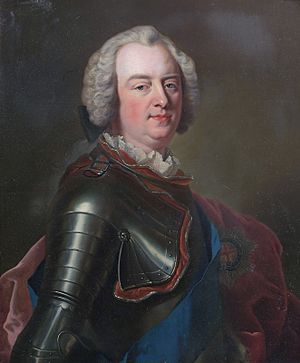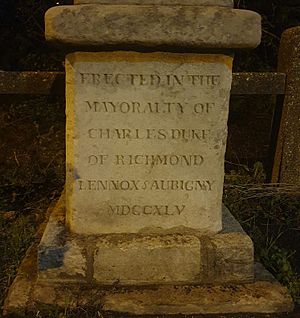Charles Lennox, 2nd Duke of Richmond facts for kids
Quick facts for kids
The Duke of Richmond and Lennox
|
|
|---|---|
 |
|
| Tenure | 27 May 1723 – 8 August 1750 |
| Successor | Charles Lennox, 3rd Duke of Richmond |
| Other titles | 2nd Duke of Lennox 2nd Duke of Aubigny (France) 2nd Earl of March 2nd Earl of Darnley 2nd Baron Settrington 2nd Lord Torbolton Hereditary Constable of Inverness Castle |
| Born | 18 May 1701 Goodwood, Sussex, England |
| Died | 8 August 1750 (aged 49) Godalming, Surrey, England |
| Spouse(s) | |
| Issue among others... |
|
| Parents |
|
Charles Lennox (born May 18, 1701 – died August 8, 1750) was a British nobleman and a very important person in early cricket history. He was known as the 2nd Duke of Richmond, 2nd Duke of Lennox, and 2nd Duke of Aubigny. He lived at Goodwood House in Sussex, England.
Charles Lennox was the son of Charles Lennox, 1st Duke of Richmond, who was a son of King Charles II of England. The 2nd Duke of Richmond was a big supporter of cricket. He helped the game grow from simple village cricket to the more organized first-class cricket we know today.
Contents
Growing Up and Becoming a Duke
From the moment he was born in 1701, Charles Lennox was called the Earl of March. This was because he was set to inherit his father's important title, the Duke of Richmond. Like his father, he loved sports, especially cricket.
When he was 12, Charles had a bad accident while hunting. He fell off his horse, but he recovered well. This accident didn't stop him from loving horses and riding.
In December 1719, when Charles was only 18, he got married. His bride was Hon. Sarah Cadogan, who was just 13. This marriage was arranged to help Charles pay off some big debts. Sarah's father had won a lot of money from Charles's father, and Sarah's dowry (money she brought to the marriage) was used to settle this. They got married in The Hague, a city in the Netherlands.
In 1722, Charles became a Member of Parliament for Chichester. He stopped being an MP in May 1723 when his father passed away. At that point, he became the 2nd Duke of Richmond. His wife, Sarah, was a great support to him throughout his life. Their marriage was very happy, especially for that time period.
His grandson, the 4th Duke of Richmond, also loved cricket. He was known as Colonel the Hon. Charles Lennox. He was a skilled amateur player in the late 1700s.
Charles Lennox: A Cricket Champion
Many people say that the Duke of Richmond was the most important supporter of cricket in its early days. He played cricket as a boy, but he became even more involved after he became a Duke.
He led his own cricket team. Some of his players were among the first known professional cricketers. One of them was his groom, Thomas Waymark. Later, he also supported the Slindon Cricket Club. He was connected to the Newland brothers, who were famous players from Slindon.
His first recorded match was on July 20, 1725. His team played against a team led by Sir William Gage, 7th Baronet.
His Own Cricket Team
We have records of four matches played by the Duke's team in the 1727 season. Two games were against Sir William Gage's team. The other two were against a team from Surrey, led by Alan Brodrick, 2nd Viscount Midleton.
These two games against Alan Brodrick were very important. Before playing, the Duke and Brodrick wrote down Articles of Agreement. These were 16 rules that had to be followed during their matches. This was likely the first time that cricket rules were formally written down. Before this, rules were usually agreed upon by talking, and they could change from place to place. The first full set of Laws of Cricket was written in 1744.
In 1728, the Duke's Sussex team played two matches against Edwin Stead's Kent team. Sussex lost both games. In 1730, the Duke's team played two more matches against Gage's team. They also played against a Surrey team and lost. One match was called off because the Duke's player, Waymark, was sick.
A Controversial Match
In 1731, the Duke was involved in a very famous and controversial cricket match. On August 16, his Sussex team played a Middlesex team in Chichester. The Middlesex team won this game, which had a prize of 100 guineas. A rematch was set for August 23 at Richmond Green.
The rematch was for 200 guineas. It's special because it's one of the earliest matches where we know the scores. The Duke's team scored 79 and 72 runs. The other team scored 119 and about 23 runs for 5 wickets. The game ended exactly at a pre-arranged time. The Middlesex team was close to winning, needing only 8 to 10 more runs.
This ending made the crowd at Richmond Green very angry. They were upset because the Duke had arrived late, which delayed the start of the game. The crowd started a riot, and some of the Sussex players even had their shirts torn! There was talk of a lawsuit because of the game. The Duke might have agreed to let the other team win to avoid legal trouble.
The Duke isn't mentioned in cricket records for ten years after this. He might have stopped playing after the riot. It's also possible he stopped leading his team after breaking his leg in 1733, which meant he couldn't play himself. Instead, he started supporting a team from a small village called Slindon, which was near his home.
Supporting the Slindon Team
The Slindon Cricket Club became famous because of the great player Richard Newland and the Duke's support. In July 1741, the Duchess of Richmond mentioned a game between Slindon and East Dean. Later that month, the Duke wrote about a game at Portslade where Slindon won, but it ended in a fight!
On September 7, 1741, Slindon played against Surrey near Guildford. The Duke wrote that it was "poor little Slyndon against almost your whole county of Surrey." The next day, he wrote that Slindon had "beat Surrey almost in one innings."
His wife, the Duchess, was very happy about the win. She even wished the "Sussex mob" had beaten the "Surrey mob" more. She remembered how the Surrey crowd had caused trouble for the Duke in 1731. She also wished the Duke had won more money from them!
In 1744, the Duke of Richmond created what is now the world's oldest known scorecard. It was for a match between London and Slindon on June 2. Slindon won that game by 55 runs. The original scorecard is still kept with the Duke's papers today.
In August 1745, the Duke supported a Sussex team against Surrey. Surrey seemed to win that game.
Single Wicket Cricket
In the late 1740s, a new form of cricket became popular called single wicket. In this game, fewer players were on each team. The Duke entered several teams, often with a player named Stephen Dingate, who worked for him. For example, a team of three players – Dingate, Joseph Rudd, and Pye – played many matches.
The Duke often played against his former groom, Thomas Waymark, who was still a great player.
The Duke of Richmond passed away on August 8, 1750. He was one of the most important early supporters of cricket, especially for the Slindon club and Sussex cricket. After he died, Sussex cricket didn't do as well for a long time. It wasn't until the Brighton Cricket Club became popular in the 1790s that Sussex cricket truly recovered.
Public Service and Other Roles
The Duke of Richmond held many important titles. He was a Knight of the Order of the Garter (KG) and the Order of the Bath (KB). He was also a Privy Counsellor (PC) and a Fellow of the Royal Society (FRS). In 1734, he also became the Duke of Aubigny in France after his grandmother passed away.
He served King George II as a Lord of the Bedchamber starting in 1727. In 1735, he was made Master of the Horse, a very important position in the royal household.
Freemasonry
The Duke became a Fellow of the Royal Society in 1724. He followed his father into freemasonry, which is a social and charitable organization. He became a Grand Master of the Premier Grand Lodge of England in 1724. His father had been a Master Mason in Chichester many years before.
As the Duke of Aubigny, he also helped bring Freemasonry to France. In 1734, he started a masonic lodge in a castle near Metz in France. A year later, he helped open another lodge in Paris.
Civic Duties
He was elected Mayor of Chichester for the years 1735–36.
The Duke of Richmond was also one of the first leaders of London's Foundling Hospital. This hospital received its special permission from King George II in 1739. The Foundling Hospital was a charity created to help London's abandoned children. Both the Duke and Duchess were very interested in this project. The Duke went to meetings, and both of them helped with the baptism and naming of the first children taken in by the hospital in March 1741.
Fighting Smuggling
The 1740s were a difficult time in Sussex because there were many smuggling gangs. One of the most dangerous was the Hawkhurst Gang. This gang was responsible for the brutal murders of a shoemaker and a customs official.
The Duke of Richmond was determined to catch those responsible. He asked the authorities to hold a special court in Chichester. He didn't trust the local judges to convict smugglers, so he arranged for judges to come from London. These judges stayed at Goodwood, where the Duke hosted them before the trials. The Duke's strong actions against the gang might have been because people worried that smugglers were helping the Jacobites, who were against the King.
All the people involved in the murders were caught and found guilty. The Duke's efforts helped reduce smuggling, but it was still a problem in Sussex even after he died.
Family Life
Richmond married Lady Sarah Cadogan (1705–1751) on December 4, 1719, in The Hague, Netherlands. They had twelve children:
- Lady Georgiana Carolina Lennox (1723–1774), who married Henry Fox, 1st Baron Holland.
- Lord Charles Lennox (born and died 1724).
- Lady Louisa Margaret Lennox (1725–1728).
- Lady Anne Lennox (1726–1727).
- Lord Charles Lennox (born and died 1730).
- Lady Emilia Mary Lennox (1731–1814), who married James FitzGerald, 1st Duke of Leinster, and later William Ogilvie.
- Charles Lennox, 3rd Duke of Richmond (1735–1806).
- Lord George Lennox (1737–1805), a General and father of Charles Lennox, 4th Duke of Richmond.
- Lady Margaret Lennox (1739–1741).
- Lady Louisa Augusta Lennox (1743–1821), who married Thomas Connolly.
- Lady Sarah Lennox (1745–1826), who married Sir Charles Bunbury, 6th Baronet, and later George Napier.
- Lady Cecilia Lennox (1750–1769), who never married.
The Duke of Richmond was buried at Chichester Cathedral. His wife, Sarah, passed away just one year after him.


